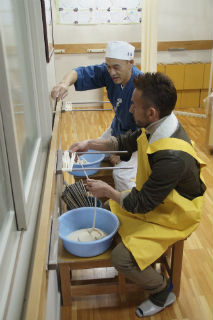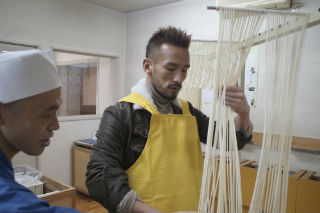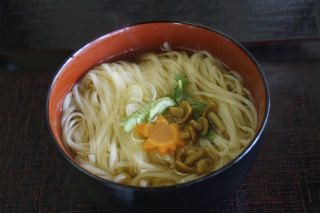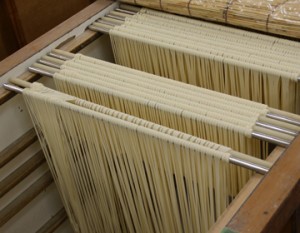1 of the 3 major “udon” noodles of Japan
The 3 major ”udon” noodles of Japan are said to be the ”Inaniwa udon” of Akita, ”Sanuki udon” of Shikoku and ”kishimen” of Nagoya. The characteristics of Inaniwa udon is that it’s texture is smooth yet firm and the more you chew, the more you will be able to savor it. Inaniwa udon first came to be at the beginning of the Edo period. It is said that Sato Ichibei who lived in Ozawa, Inaniwa village under the rule of the Akita clan (current Ozawa Inaniwamachi Yuzawa-City) started to make dry udon using local flour. It was so good he soon became purveyor to the Akita clan. Back then, it was too expensive for commoners. It became known as a speciality of Akita after the Meiji period. It has since received many awards across the country, and is now considered a leading food item of Akita.

“Air” creates the unique texture
We visited Sato Yosuke Shoten and learned how to make Inaniwa udon. Ordinarily, Inaniwa udon is made over a span of 3 days. First the flour is kneaded with salt water. Takahashi, the factory manager, said that the amount of salt is never the same and is adjusted according to the humidity and temperature. When in doubt, he touches his earlobes to remind him of the ideal texture of the dough. The key to creating good dough is to knead in as much air as you can, eventually creating the firm, strong texture of the udon. It is then stretched out long, all by hand, as though twisting rope and here too, Nakata gives it a try. He tries stretching the udon and hanging it over 2 poles. While admitting the task was difficult, Nakata surprises the factory manager with his graceful moves. Takahashi repeatedly remarked on how he couldn’t believe it was Nakata’s first try. The stretched out udon is then left to dry. ”This entire procedure is done by instinct. That’s why it cannot be made anywhere else.” Takahashi commented.

Hot Inaniwa udon
Finally, we feasted on the udon. Although it was said to have spread after the Meiji period, the recipe was never revealed to the public, and the secret recipe was handed down within the family. Distribution routes were therefore limited to dedication to the Imperial Palace, but in 1972, when the manufacturing method was made public, it spread quickly.
We had hot udon. Perhaps the cold inaniwa udon is more commonly known, but hot Inaniwa udon was just as good. It was so good we enjoyed every little mouthful.
One of the leading food items of Akita, the Inaniwa udon. A culture accredited to masterful craftsman.





